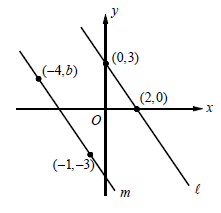FIND THE MISSING VALUE IF TWO LINES ARE PARALLEL OR PERPENDICULAR
Subscribe to our ▶️ YouTube channel 🔴 for the latest videos, updates, and tips.
If two lines are parallel, then slopes of two lines will be equal.
m1 = m2
If two lines are perpendicular, then the product of the slopes will be equal to -1.
m1 ⋅ m2 = -1
Question 1 :
Find the slope of the straight line
(i) 3x + 4y -6 = 0
Answer :
Slope (m) = - Coefficient of x/coefficient of y
= -3/4
(ii) y = 7x + 6
Answer :
y = 7 x + 6
By comparing the given equation with slope intercept form (y = mx + b), we get
Slope = 7
(iii) 4 x = 5y + 3
Answer :
4 x - 5 y - 3 = 0
Slope (m) = - coefficient of x/coefficient of y
= -4/(-5) = 4/5
Question 2 :
Show that the straight lines x + 2 y + 1 = 0 and 3x + 6y + 2 = 0 are parallel
Answer :
Since the given lines are parallel, m1 = m2
Slope of the first line x + 2 y + 1 = 0
Slope (m) = - coefficient of x/coefficient of y
m1 = -1/2 ----(1)
Slope of the second line 3x + 6y + 2 = 0
m2 = -3/6 = -1/2 ----(2)
(1) = (2)
Then the given lines are parallel.
Question 3 :
Show that the straight lines 3x – 5y + 7 = 0 and 15 x + 9y + 4 = 0 are perpendicular.
Answer :
If two lines are perpendicular then
m1 x m2 = -1
Slope of the first line 3x - 5 y + 7 = 0
Slope (m) = - coefficient of x/coefficient of y
m1 = -3/(-5)
= 3/5
Slope of the second line 15x + 9y + 4 = 0
m2 = -15/9 = -5/3
m1 ⋅ m2 = (3/5) x (-5/3) = -1
Hence the given lines are perpendicular.
Question 4 :
If the straight lines y/2 = x – p and ax + 5 = 3y are parallel, then find a.
Answer :
|
y/2 = x – p y = 2(x - p) y = 2x - 2p m1 = 2 -----(1) |
ax + 5 = 3y y = (a x + 5)/3 y = (a/3)x + (5/3) m2 = a/3 -----(2) |
(1) = (2)
2 = a/3
a = 6
Question 5 :
Find the value of a if the straight lines 5x – 2y – 9 = 0 and ay + 2x – 11 = 0 are perpendicular to each other.
Answer :
|
5x – 2y – 9 = 0 m1 = -5/(-2) m1 = 5/2 -----(1) |
ay + 2x – 11 = 0 m2 = -a/2 ----(2) |
m1 ⋅ m2 = -1
(5/2) ⋅ (-a/2) = -1
-5a/4 = -1
5 a = 4
a = 4/5
Question 6 :
- The line Q passes through the points (−10, −2) and (−8, −8)
- The line R passes through the points (1, 2) and (10, a)
The lines Q and R are perpendicular. Find the value of a
Answer :
The lines P and Q are perpendicular to each other.
Slope of the line P = (-8 - (-2))/(-8 - (-10))
= (-8 + 2)/(-8 + 10)
= -6/2
= -3
Slope of the line Q = (a - 2) / (10 - 1)
= (a - 2) / 9
Product of the slopes = -1
-3 ⋅ (a - 2) / 9 = -1
a - 2 = 3
a = 3 + 2
a = 5
So, the value of a is 5.
Question 7 :
A line passes through the points (-1, 2) and (5, b) and is parallel to the graph of the equation 4x - 2y = 13, what is the value of b ?
Answer :
If two lines are parallel, then slopes will be equal
Slope of the line passes through the points (-1, 2) and (5, b)
= (b - 2) / (5 - (-1))
= (b - 2) / (5 + 1)
= (b - 2) / 6
Slope of the line 4x - 2y = 13
2y = 4x - 13
y = (4x/2) - 13/2
y = 2x - (13/2)
Slope = 2
(b - 2) / 6 = 2
b - 2 = 2(6)
b - 2 = 12
b = 12 + 2
b = 14
So, the value of b is 14.
Question 8 :

In the xy-plane above, line l is parallel to line m. What is the value of b?
Answer :
Since the shown lines are parallel, they will have same slope.
Slope of line passes through the points (-4, b) and (-1, -3)
= (-3 - b) / (-1 -(-4))
= (-3 - b) / (-1 + 4)
= (-3 - b) / 3 ------(1)
Slope of the line passes through the points (0, 3) and (2, 0)
= (0 - 3) / (2 - 0)
= -3/2 ---------(2)
(-3 - b) / 3 = -3/2
(3 + b) / 3 = 3/2
2(3 + b) = 3(3)
6 + 2b = 9
2b = 9 - 6
2b = 3
b = 3/2
So, the value of b is 3/2.
Question 9 :
In the system of equations above, a and b are constants and x and y are variables. If the system of equations above has no solution, what is the value of a⋅b?
ax - y = 0
x - by = 1
Answer :
ax - y = 0
x - by = 1
When the system of equation has no solution, they must be parallel and they will have same slope.
y = ax
Slope = a
by = x - 1
y = (1/b) x - (1/b)
Slope = 1/b
a = 1/b
a⋅b = 1
Subscribe to our ▶️ YouTube channel 🔴 for the latest videos, updates, and tips.
Kindly mail your feedback to v4formath@gmail.com
We always appreciate your feedback.
About Us | Contact Us | Privacy Policy
©All rights reserved. onlinemath4all.com

Recent Articles
-
10 Hard SAT Math Questions (Part - 39)
Dec 28, 25 11:20 PM
10 Hard SAT Math Questions (Part - 39) -
10 Hard SAT Math Questions (Part - 41)
Dec 28, 25 06:05 PM
10 Hard SAT Math Questions (Part - 41) -
GMAT Quantitative Reasoning Questions and Answers
Dec 27, 25 09:33 PM
GMAT Quantitative Reasoning Questions and Answers
